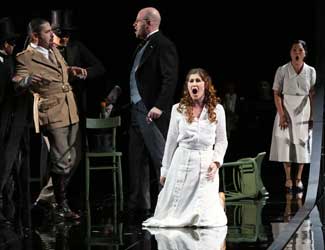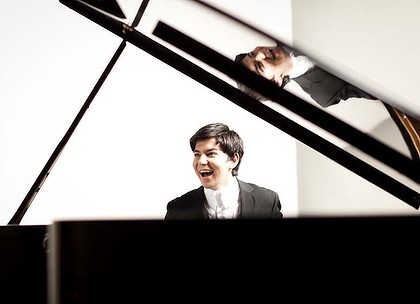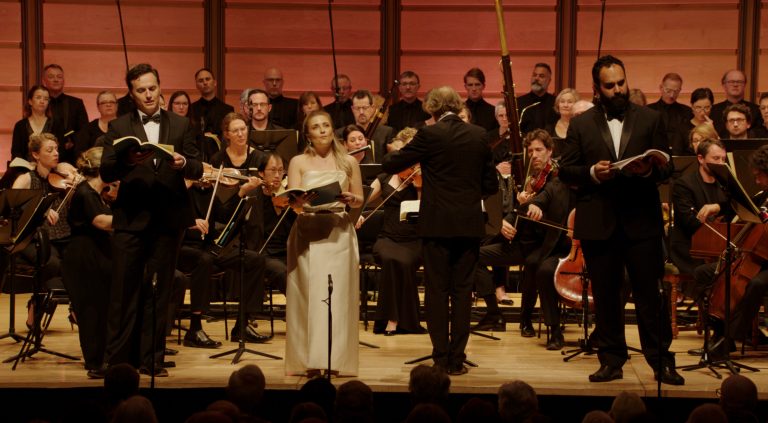Opera Review: Luisa Miller/Opera Australia

It is well worth getting to the Joan Sutherland Theatre a little ahead of the performance of Verdi’s Luisa Miller to contemplate the diorama that presages the production. In stark tones of black and white, the scene is one of formulaic domestic bliss. Could that be a bust of Verdi smiling benignly down on the family? Outside, looking in lurks a shadowy figure – Count Walter.
As the performance begins, the set is hoisted up and overturned – happiness is out of reach; everything is topsy-turvy. The diorama hangs overhead – menacing yet fragile. The single set of three panels it reveals is of black marble and silver mirrors. It stays with us until nearly the last moments of the opera. The shadows and the mirrors underscore the duplicity and conspiracies in the story. The colour palette of costumes and set (William Orlandi) remain funereal. The visual components are minimal; the chorus moves en bloc, wooden and stifled. Together, they are an unobtrusive frame for the brilliance of Verdi’s elaborate writing and the powerful vocal and dramatic performances.
Luisa Miller, a co-production between Opera Australia and Opera Lausanne directed by Giancarlo del Monaco premiered in Lausanne in 2014. It opened in Sydney last week with the revival directed by Barbara Staffolani who was Assistant Director of the Lausanne production. Andrea Licata conducted the ensemble with Nicole Car in the title role, Diego Torre as Rodolfo, Dalibor Jenis as Miller, Daniel Sumegi as Wurm, Raymond Aceto as the Count, Sian Pendry as Federica and Eva Kong as Laura with the chorus of the Australian Opera and the Australian Opera and Ballet Orchestra.
Verdi’s Melodramma tragico in three acts – Love, The Intrigue and The Poison, has a libretto by Salvadore Cammarano (he also wrote the libretto to Lucia di Lammermoor) based on Friedrich von Schiller’s play Kabale und Liebe. It premiered at the Teatro San Carlo in Naples in 1849. Its journey to the stage was complex – but that’s another story. The opera entered the repertory but was never as popular as Nabucco or Ernani and was forgotten until the 1920s when it was revived in Germany.
Luisa Miller is set in the Tyrol in the early 17th century, but del Monaco’s production takes us to the 1930s with the men in dapper suits and the women in flapper style, bearing heavily symbolic white flowers and reflecting the monochromatic and abstract set. This production is realised as a flashback which works retrospectively from the death of Luisa, giving a fresh take on the opening chorus Ti desta, Luisa, exhorting Luisa to wake up to an April morning, gently rocked by the chorus and wind instruments of the orchestra.
But let’s get down to the music. It is undoubtedly written in grand style, demanding great stamina from the leading roles, especially in the second half. Nicole Car combines a naiveté and fragility with vocal power and an unerring tone. The delicacy of her singing in the cavatina Lo vidi, e ’l primo palpito belies the myriad emotions and technical prowess she draws on as Luisa journeys to her death. Car more than matches the octane fuelled ensembles, her voice giving full flight to the soprano line.
Dalibor Jenis makes a welcome return to the Sydney stage as Miller to reprise his collaboration with Car. Seen together as lovers in Eugene Onegin, this time they play father and daughter, a relationship that Verdi later drew on between Gilda and Rigoletto. Jenis portrays a concerned and helpless parent, (literally) hamstrung by a lame leg. A walking stick is used with subtle but great effect to underscore his attempt so ‘stand up’ to forces greater than him. He colours his singing with the patina of age creating a velvet legato as in the expansive and paternal Sacra la scelta è d’un consorte contrasting with impotent rage especially evident in Ah! fu giusto il mio sospetto.
As Rodolfo, Diego Torre gives a towering performance. It was curious however that he had to begin his showstopper Quando le sere al placido far into the back of the stage and up high with the chorus shuffling in front of him. Nonetheless it is one of the highlights of the opera and Torre’s performance is finessed with his trademark power, flexibility and beauty of line.
American bass Raymond Aceto made his OA debut as Count Walter. A thrilling voice and dramatic talent. A suitable foil to the equally thrilling and menacing tones of Daniel Sumegi’s impeccable depiction of Wurm. Sian Pendry as Federica accomplished a difficult task breathing life into a fairly lacklustre character. Eva Kong completed the accomplished cast of principals as a dutiful Laura.
The vocal ensemble was well matched in strength and timbre, defining characters and reactions, balancing themes, counter-themes and multiple tempi. Andrea Licata brilliantly led an instrumental ensemble in prime form, each section stepped up to its moments to shine in Verdi’s canvas. The string section in particular achieved the brightness and rhythmicity of Verdi’s signature style.
In the last moments the tableau returned to gravity. There were some distracting moments as the dying characters made way for the machinery. In the end, conformity engineered by intrigue, triumphed over the heart.
Although Luisa Miller lacks the spine-tingling choruses of some of Verdi’s operas, it contains some of his cleverest and most glorious writing for soloists, small ensemble and orchestra. It is said to lie on the cusp of his early style reflecting the bel canto of Bellini and Donizetti before his own more mature voice emerges in Rigoletto and La traviata. Well worth the evening for this reason and for the stellar performances by all – on as well below the stage: Love, Intrigue and Poison.
Shamistha de Soysa for SoundsLikeSydney©
Luisa Miller is being performed in the Joan Sutherland Theatre of the Sydney Opera House until February 29, 2016.







